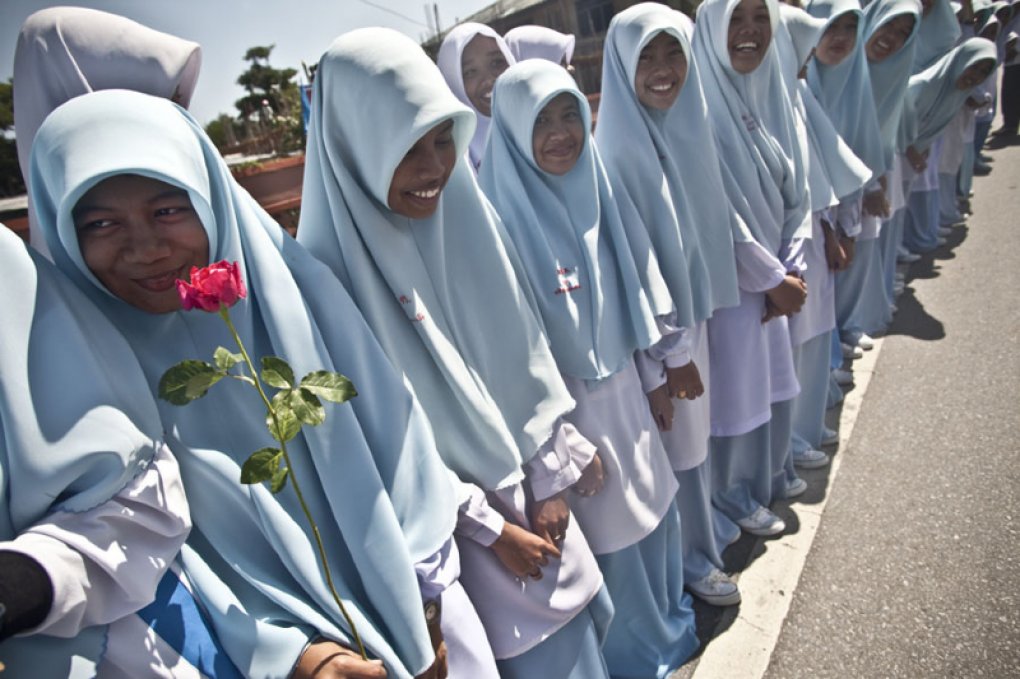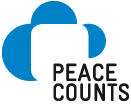Thailand: Gothoms’s March
 Text based on reportage by Uschi Entenmann
Text based on reportage by Uschi Entenmann
Photos: Lukas Coch
A peace march of over one thousand kilometres, from Bangkok to Thailand’s southernmost province of Pattani: That was the idea that took shape in the mind of Gothom Arya, director of Bangkok’s Research Center for Peace Building. His hope was to draw attention to one of the world’s forgotten conflicts. In southern Thailand, conflict between government troops and Muslim rebels claims hundreds of lives every year.
The pilgrims rest on the stone floor of a mosque in Songhkla, exhausted from the distance they walked that day, around eighteen miles in temperatures of thirty-five degrees in the shade. But there is little shade to be had on the one thousand kilometre stretch from Bangkok to Pattani Province in southern Thailand. Relief from the sweltering heat comes only on rare occasions when monsoon rains drench them to the skin.
Gothom Arya is sixty-six years old, but has not a single gray hair. He is the only marcher who has walked every stage of the journey, from Bangkok all the way to Pattani. Already thin when he started, the man has lost nearly ten pounds. But his resolve is unshaken. The march was his idea, after all. Since the marchers arrived in the southern, mostly Muslim part of the country, Gothom has been following the command to fast during Ramadan, even though he is not Muslim. For him, fasting with his hosts is a mark of respect.
Gothom Arya learned early to look beyond his own borders. At seventeen, he took a scholarship to France to study electrical engineering. Politics was only a marginal interest then. But the student protests in Paris in May 1968 had a tremendous influence on him. He returned home as a committed political activist, eager to help his own country.
After accepting a teaching position at a university in Bangkok, he founded the first Thai human rights organization. He worked as an election observer, and later as a permanent member of the election commission.
“What matters to me is religious tolerance and respect for ways of life different from our own.” That’s how Gothom explains his idea of a peace march to people he meets along the way.
Thailand has three million Muslims, three-quarters of them in the south. People here tell Gothom that poverty among farmers in the region rose with a decline in the price of raw rubber. Income from tourism is falling as well, they say. They feel the government in Bangkok has abandoned them, and they identify more closely with the neighboring Islamic nation of Malaysia than with the Buddhist majority that dominates their own country.
The peace marchers must pass through numerous roadblocks along the way. The government declared martial law in Pattani, the province where they are headed, in 2004, and sixty thousand soldiers were sent from Bangkok to keep the peace. But bombs still go off regularly in Buddhist monasteries and public schools, expressions of resistance by Muslim rebel groups who oppose the presence of government forces. The result has been more than four thousand dead and tens of thousands injured since 2004.
Those numbers left Gothom no peace. Three people dying every day, and no one seems to notice! Hardly anyone in Thailand, much less the world at large, finds out what is going on, possibly because there have still been no foreign citizens among the dead. The sheer mass of the casualties is what led Gothom to set off on his tough fifty-day walk.
The place where Gothom normally works at building peace is not the open road, but an airconditioned office at a university in Bangkok. He has been the director of its Research Center for Peace Building for seven years.
His home base here allows him to organise dialogue sessions with government ministers, police chiefs, generals, and influential Buddhists and Muslims.
He is paid for his work by the government, including salaries for a staff of nineteen. His official mission is to craft a transition to nonviolence for the Muslim rebels in the south. But there is much to be done even in the capital.
In March 2010 the global media focused briefly on Thailand’s “redshirt” movement. They came from the poorer provinces of the north, and for several weeks they occupied Bangkok’s most upscale business district.
They are followers of a former head of state, Thaksin Shinawatra, who supported rural development and introduced universal health care. The monarchy felt threatened, and in 2006 he was forced out by a military coup. It was also the army, with its royalist sympathies, that put down the 2010 redshirt rebellion, killing ninety people in the process.
It is to Gothom Arya’s credit that the tally of victims remained so low. He managed to have a temple near the demonstrations declared a no-weapons zone. People were able to run to safety before the shooting began. He was later accused by the monarchist yellowshirts of having taken the redshirts’ side. The yellowshirts are relatively wealthy families, businesspeople, and professionals loyal to the Thai royal family.
The redshirt movement, with its calls for democracy, receives support from the poorer classes as well as locally prominent farmers and union organisers.
Jitra is a union organiser on the redshirt side. She was one of four thousand seamstresses employed in Bangkok by the clothing manufacturer Triumph. Eight hours of piece work every day, for the equivalent of two hundred and thirty euros a month, with no vacations.
Anyone who made a mistake was immediately fired. As was anyone who got sick. When Jitra discovered that plant managers were stealing money, she founded a union. Almost the entire workforce at the plant chose to join.
But demanding their rights had unwelcome consequences. Jitra explains that two thousand workers were fired from one day to the next, leading to a strike by all the union members – for six weeks, until they were all re-hired.
All of them but their leader, Jitra. She has her own business now, piecing together women’s underwear and bathing suits that she sells on the street. “I don’t trust anyone anymore. Not the politicians and not the king. What we need is to finally get democracy!” Jitra cries out at a dialogue forum organized by Gothom Arya at his university.
The discussion includes student spokeswomen, businesspeople, and Buddhist monks. “It’s terrible you lost your job, but what does the king have to do with it?” a businessman objects. Gothom lets them talk. Nothing more. He makes no attempt to mediate or arbitrate. He is satisfied when one side is exposed to the values and desires of the other. It’s a start, at least. He is counting on a ripple effect: These are people who could serve as multipliers when they return to their home environments.
He intervenes only when emotions threaten to boil over. “When we are angry, we perceive our enemies as more hostile than they really are,” Gothom tells the group. “We should look for common ground instead. No one wants to overthrow anyone else. We are afraid of the military and of the power of the monarchy. But these powers exist, and they need to find new roles.”
The discussion ends without a resolution. But the participants feel their burden has been lightened, because they were able to express their opinions and concerns.
The king, once generally acknowledged as the country’s highest authority, is already old and ill. Gothom is afraid of the day when the king dies. He has already lost control over his wife, his son, and his country.
Criticism of the royal family is accounted a crime punishable by fifteen years in prison. It is clear to opponents of the monarchy that when the king goes, he may be replaced by something much worse – civil war, everyone against everyone else. With such threats looming, even Gothom has doubts whether his approach based on dialogue will do the job in the long term.
The decision to launch a proactive initiative originated in a Buddhist monastery. Gothom goes there once a year to find himself, and he was assigned the task of spending seven hours walking twelve steps forward and twelve steps back. He was required to take long steps and to do this without thinking. He tried. But after a while the engineer in him got the upper hand, and he calculated how long it might take to walk from Bangkok to Pattani.
The result he came up with was fifty days, and the idea for the peace march was born. In August 2010 he set off with a small team. A former professor, a few students, a few departmental employees. “I thought they would think I was crazy when I suggested this action,” he says.
“But they were enthusiastic.” The farther they walked, the more the group expanded. Some people joined them for only a day or two. They were especially touched when the march was joined by nine orphan children and their kindergarten teacher, who kept up for quite a while despite suffering from cancer.
For the last stage, they were joined by five hundred mostly female students from the University of Pattani as well as hundreds of nuns, monks, Muslims, schoolchildren, and farmers.
The triumphal peace march received nationwide media coverage both in newspapers and on television. Gothom had succeeded in attracting public attention to a forgotten region.
In Pattani, entire school classes lined the road and the walkers distributed flowers. People on the roadside greeted them with chilled drinks and fruit. When the movement arrived in Pattani after fifty-three days, the march and its message of peace had attained their goal.


